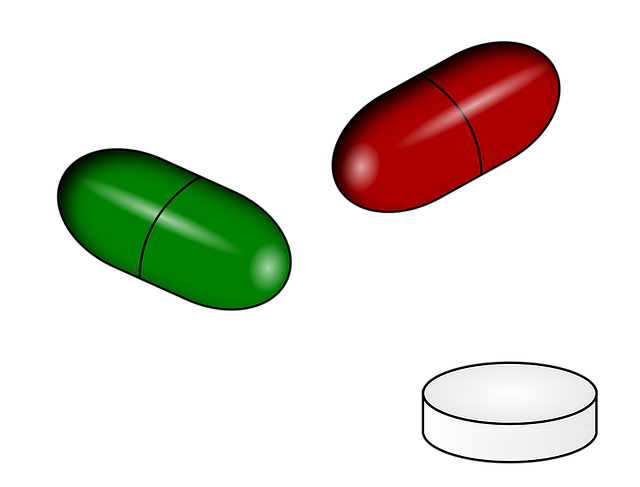Semaglutide medication is a groundbreaking treatment for type 2 diabetes that mimics natural appetite-regulating hormones, GLP-1. By binding to brain receptors, it promotes feelings of fullness and reduces hunger, leading to decreased calorie intake. This dual action not only aids in weight management but also improves blood sugar control by slowing gastric emptying. Clinical trials have shown significant reductions in HbA1c levels, up to 2%, while real-world evidence indicates improved quality of life and lower complication risks. However, it should be administered with caution due to potential side effects and requires close monitoring by healthcare professionals. Semaglutide offers a promising solution for diabetes care, combining appetite control with glycemic management.
Diabetes management requires a multifaceted approach, and one innovative solution lies in appetite regulation. This article explores semaglutide medication as a novel strategy to combat this chronic condition. We delve into how semaglutide targets hunger hormones, offering significant benefits in blood sugar control. From its mechanism of action on the gut to potential side effects and real-world efficacy demonstrated through clinical trials, this comprehensive guide provides insights into integrating semaglutide into diabetes care plans.
Understanding Diabetes and Its Impact on Appetite Regulation

Diabetes is a chronic condition characterized by elevated blood sugar levels, often due to insufficient insulin production or effectiveness. This hormonal imbalance can significantly impact appetite regulation, leading to increased hunger and potential weight gain. In type 2 diabetes, for instance, resistance to insulin’s effects on glucose metabolism also extends to other metabolic processes, including appetite control. As a result, individuals may experience fluctuations in their appetite, making it challenging to maintain a healthy diet and manage blood sugar levels effectively.
The semaglutide medication has emerged as a novel approach to addressing this complex issue. Semaglutide is a synthetic hormone that mimics the effects of natural gut hormones, helping to regulate appetite and reduce food intake. By activating specific receptors in the brain, it promotes feelings of fullness and satiety, thereby supporting better dietary choices and blood sugar control. This dual action not only aids in weight management but also simplifies diabetes care by potentially reducing the need for frequent insulin injections or complex carbohydrate counting.
Introduction to Semaglutide: A Novel Approach for Diabetes Management

Semaglutide is a groundbreaking medication that has emerged as a novel approach to managing diabetes, particularly type 2 diabetes. It works by mimicking a natural hormone in your body called GLP-1 (glucagon-like peptide-1), which plays a crucial role in regulating blood sugar levels and appetite. By stimulating the same receptors as GLP-1, semaglutide helps to lower blood glucose levels and reduce hunger pangs, making it a powerful tool in diabetes management.
This medication has shown remarkable results in clinical trials, offering improved glycemic control when compared to other diabetes treatments. Its unique mode of action not only reduces blood sugar but also promotes weight loss, which is an added benefit for individuals struggling with obesity and type 2 diabetes. The flexibility of semaglutide administration, often through once-weekly injections, makes it a convenient option for patients, potentially improving adherence to treatment regimens.
How Semaglutide Medication Works to Control Hunger Hormones

Semaglutide medication works by mimicking a natural hormone that regulates appetite, called GLP-1 (glucagon-like peptide-1). When injected into the body, semaglutide binds to specific receptors in the brain, signaling the feeling of fullness and reducing hunger pangs. This action helps individuals eat less and manage their calorie intake effectively.
By controlling the hormones that stimulate appetite, semaglutide medication plays a crucial role in diabetes management. It not only aids in weight loss but also improves blood sugar control by slowing gastric emptying, allowing for better absorption of nutrients and more stable blood glucose levels. This dual benefit makes semaglutide a valuable tool for those living with both type 2 diabetes and obesity.
Benefits of Semaglutide in Lowering Blood Sugar Levels

Semaglutide, a medication that mimics a natural hormone, has shown remarkable effectiveness in regulating blood sugar levels for individuals with diabetes. Its primary benefit lies in its ability to reduce hunger and promote feelings of fullness, leading to a significant decrease in overall calorie intake. This mechanism not only aids in weight management but also helps in achieving better glycemic control. By reducing the appetite, semaglutide allows diabetics to make healthier food choices and maintain stable blood sugar levels throughout the day.
The medication has been found to lower HbA1c (a measure of long-term blood sugar control) by up to 1.5%, making it a valuable tool in diabetes management. Clinical trials have demonstrated its safety and efficacy, with many patients experiencing substantial improvements in their condition. Semaglutide’s ability to mimic the body’s natural appetite-regulating hormones offers a novel approach to diabetes treatment, providing hope for better health outcomes and an improved quality of life for those living with this chronic condition.
Clinical Trials and Real-World Evidence of Semaglutide's Efficacy

Clinical trials and real-world evidence have consistently shown the efficacy of semaglutide medication in managing diabetes. Numerous studies have demonstrated its ability to significantly lower blood sugar levels, offering a promising solution for patients with type 2 diabetes. Semaglutide works by mimicking the effects of a natural hormone that regulates appetite, leading to reduced food intake and improved glycemic control.
In clinical trials, semaglutide has been shown to reduce HbA1c (a measure of long-term blood sugar control) by up to 2% compared to placebo or other standard treatments. Real-world evidence further supports these findings, indicating that patients on semaglutide therapy often experience improved quality of life and reduced risks associated with diabetes complications. This medication’s dual role in appetite regulation and glycemic management makes it a game-changer in diabetes treatment.
Exploring Semaglutide's Mechanism of Action on the Gut

Semaglutide, a pioneering medication in diabetes management, operates on a unique mechanism that involves direct interaction with the gut. Its primary mode of action is to regulate appetite by mimicking a natural hormone, GLP-1 (glucagon-like peptide-1), which is produced by the intestines in response to food intake. When semaglutide binds to specific receptors in the gut, it triggers a cascade of effects that result in increased feelings of fullness and reduced hunger.
This gut-centric approach not only aids in weight management, a crucial factor for diabetes control, but also influences insulin secretion and glucose metabolism. By slowing gastric emptying, semaglutide helps maintain stable blood sugar levels, thereby reducing the need for frequent insulin injections. This dual action makes semaglutide a game-changer in treating type 2 diabetes, offering both appetite regulation and improved glycemic control.
Potential Side Effects and Safety Considerations with Semaglutide Therapy

Semaglutide, a medication designed to regulate appetite and manage diabetes, has shown significant promise in clinical trials. However, like any pharmaceutical intervention, it’s crucial to consider potential side effects. Common adverse reactions include nausea, vomiting, diarrhea, and constipation—often experienced during the initial stages of treatment and typically resolve as the body adjusts. These gastrointestinal issues can be managed with dietary adjustments and medication modifications if necessary.
Safety is paramount when initiating semaglutide therapy. Patients must be monitored for hyperglycemia (high blood sugar), a potential risk factor, especially those with kidney problems or using other diabetes medications. Regular check-ups are essential to ensure the treatment remains beneficial and safe. Additionally, the medication can cause weight loss, so healthcare providers should assess patients’ overall health and well-being throughout the course of treatment.
Integrating Semaglutide into Comprehensive Diabetes Care Plans

Semaglutide, a medication known for its appetite-regulating properties, has emerged as a valuable tool in comprehensive diabetes care plans. Its role goes beyond simply managing hunger; it actively contributes to blood sugar control, making it a game-changer for diabetics. By mimicking a natural hormone that promotes satiety, semaglutide helps reduce calorie intake and supports weight management, two crucial aspects of diabetes treatment.
Integrating this medication into care plans requires a thoughtful approach. Healthcare professionals should consider individual patient needs, including their current medications and lifestyle factors. Semaglutide is typically prescribed for adults with type 2 diabetes who meet specific criteria, ensuring its effective use. Regular monitoring and adjustments are vital to optimize its benefits while minimizing potential side effects, enabling patients to actively participate in their diabetes management journey.
Future Perspectives: Research and Innovations in Semaglutide for Diabetes Management

As research continues to advance, the future of diabetes management looks promising with innovations like semaglutide medication at the forefront. Semaglutide, a type of glucagon-like peptide-1 (GLP-1) receptor agonist, has shown remarkable potential in regulating blood sugar levels and aiding in weight management—two crucial aspects of diabetes control. Ongoing studies explore its long-term effects, with initial results suggesting sustained benefits and reduced risks compared to other treatments.
The versatility of semaglutide offers exciting prospects for personalized diabetes care. Future research may uncover additional applications beyond type 2 diabetes, potentially expanding its use in type 1 diabetes management. Innovations in delivery methods, such as long-acting formulations, could further enhance patient convenience and adherence. As we move forward, continued exploration of semaglutide’s capabilities will contribute to more effective and accessible diabetes management strategies.
